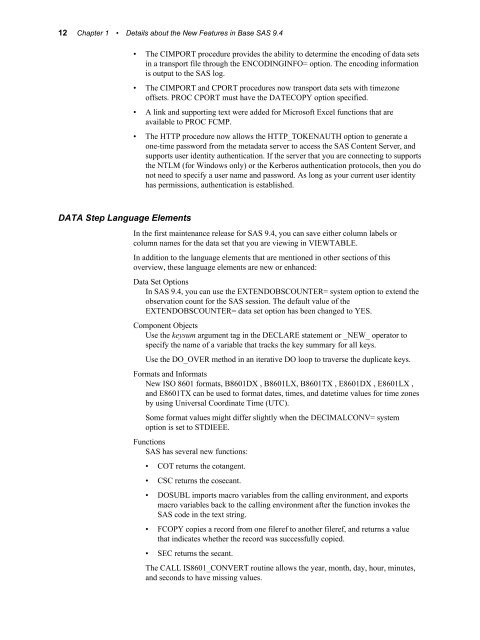What's New in Base SAS: Details
What's New in Base SAS: Details
What's New in Base SAS: Details
Create successful ePaper yourself
Turn your PDF publications into a flip-book with our unique Google optimized e-Paper software.
12 Chapter 1 • <strong>Details</strong> about the <strong>New</strong> Features <strong>in</strong> <strong>Base</strong> <strong>SAS</strong> 9.4<br />
• The CIMPORT procedure provides the ability to determ<strong>in</strong>e the encod<strong>in</strong>g of data sets<br />
<strong>in</strong> a transport file through the ENCODINGINFO= option. The encod<strong>in</strong>g <strong>in</strong>formation<br />
is output to the <strong>SAS</strong> log.<br />
• The CIMPORT and CPORT procedures now transport data sets with timezone<br />
offsets. PROC CPORT must have the DATECOPY option specified.<br />
• A l<strong>in</strong>k and support<strong>in</strong>g text were added for Microsoft Excel functions that are<br />
available to PROC FCMP.<br />
• The HTTP procedure now allows the HTTP_TOKENAUTH option to generate a<br />
one-time password from the metadata server to access the <strong>SAS</strong> Content Server, and<br />
supports user identity authentication. If the server that you are connect<strong>in</strong>g to supports<br />
the NTLM (for W<strong>in</strong>dows only) or the Kerberos authentication protocols, then you do<br />
not need to specify a user name and password. As long as your current user identity<br />
has permissions, authentication is established.<br />
DATA Step Language Elements<br />
In the first ma<strong>in</strong>tenance release for <strong>SAS</strong> 9.4, you can save either column labels or<br />
column names for the data set that you are view<strong>in</strong>g <strong>in</strong> VIEWTABLE.<br />
In addition to the language elements that are mentioned <strong>in</strong> other sections of this<br />
overview, these language elements are new or enhanced:<br />
Data Set Options<br />
In <strong>SAS</strong> 9.4, you can use the EXTENDOBSCOUNTER= system option to extend the<br />
observation count for the <strong>SAS</strong> session. The default value of the<br />
EXTENDOBSCOUNTER= data set option has been changed to YES.<br />
Component Objects<br />
Use the keysum argument tag <strong>in</strong> the DECLARE statement or _NEW_ operator to<br />
specify the name of a variable that tracks the key summary for all keys.<br />
Use the DO_OVER method <strong>in</strong> an iterative DO loop to traverse the duplicate keys.<br />
Formats and Informats<br />
<strong>New</strong> ISO 8601 formats, B8601DX , B8601LX, B8601TX , E8601DX , E8601LX ,<br />
and E8601TX can be used to format dates, times, and datetime values for time zones<br />
by us<strong>in</strong>g Universal Coord<strong>in</strong>ate Time (UTC).<br />
Some format values might differ slightly when the DECIMALCONV= system<br />
option is set to STDIEEE.<br />
Functions<br />
<strong>SAS</strong> has several new functions:<br />
• COT returns the cotangent.<br />
• CSC returns the cosecant.<br />
• DOSUBL imports macro variables from the call<strong>in</strong>g environment, and exports<br />
macro variables back to the call<strong>in</strong>g environment after the function <strong>in</strong>vokes the<br />
<strong>SAS</strong> code <strong>in</strong> the text str<strong>in</strong>g.<br />
• FCOPY copies a record from one fileref to another fileref, and returns a value<br />
that <strong>in</strong>dicates whether the record was successfully copied.<br />
• SEC returns the secant.<br />
The CALL IS8601_CONVERT rout<strong>in</strong>e allows the year, month, day, hour, m<strong>in</strong>utes,<br />
and seconds to have miss<strong>in</strong>g values.
















